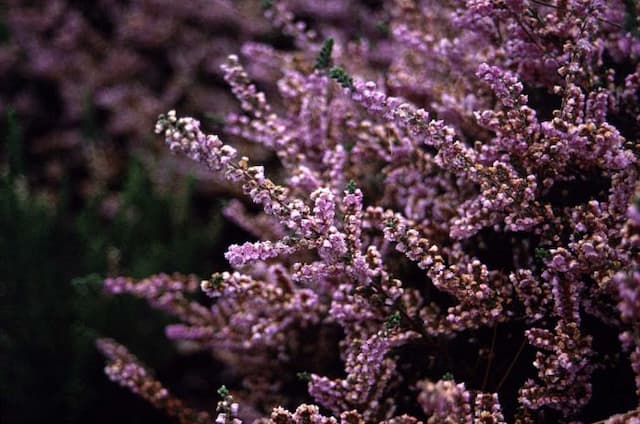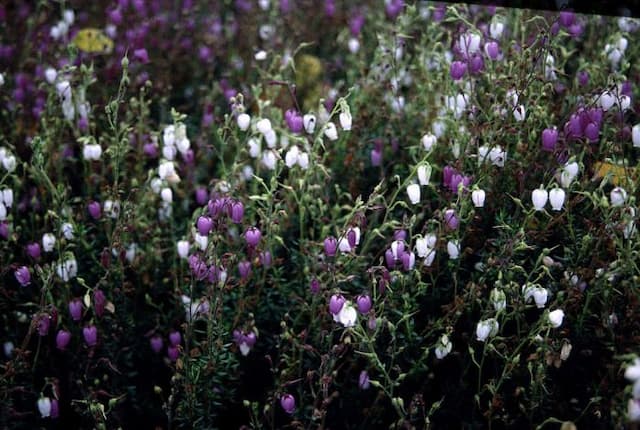Rhododendron Rhododendron (Loderi Group) 'Loderi King George'

ABOUT
The Rhododendron 'Loderi King George' is an attractive evergreen shrub known for its impressive display of blooms. It bears large, showy flowers that cluster at the end of the branches. These flowers are typically a soft pink shade, often with a slightly deeper blush at the petal edges and a paler center. The blooms have a prominent structure with a trumpet-like shape, and they may emit a delightful fragrance that can permeate the surrounding garden area. The leaves of 'Loderi King George' are equally striking, being large, glossy, and dark green. They are elongated with a leathery texture and have a bold presence that complements the floral display. The new growth on the plant can sometimes exhibit a lighter green shade, adding to the visual interest throughout the growing season. The overall shape of Rhododendron 'Loderi King George' is typically a rounded habit, with a dense, lush foliage that creates a backdrop for the floral spectacle in the blooming season. This plant is prized for its contribution to the aesthetic of woodland settings, shaded borders, and as a feature plant in ornamental gardens. Its capacity to provide such transformative bursts of color, alongside its attractive foliage, makes it a favored choice for enhancing the visual appeal of outdoor spaces.
About this plant
 Names
NamesFamily
Ericaceae.
Synonyms
Loderi King George Rhododendron, Rhododendron 'Loderi King George'.
Common names
Rhododendron 'Loderi King George'.
 Toxicity
ToxicityTo humans
Rhododendrons are known to be toxic to humans if any parts are ingested. They contain a toxin called grayanotoxin, which can affect sodium channels in the cells and can lead to poisoning. Symptoms of rhododendron poisoning include vomiting, diarrhea, hypersalivation, weakness, coma, hypotension, CNS depression, cardiovascular collapse, and potentially death if consumed in significant quantities. Caution is advised to prevent ingestion of any part of the plant, as it could lead to serious health consequences.
To pets
Rhododendrons are also toxic to pets, such as dogs and cats. Like humans, if pets ingest any part of a rhododendron plant, they can suffer from grayanotoxin poisoning. Symptoms that may occur in pets after consumption include vomiting, diarrhea, drooling, weakness, leg paralysis, depression of the central nervous system, coma, hypotension, and potentially death. It is important to keep pets away from rhododendrons to prevent accidental ingestion and possible poisoning.
 Characteristics
CharacteristicsLife cycle
Perennials
Foliage type
Evergreen
Color of leaves
Green
Flower color
Pink
Height
20 feet (6 meters)
Spread
25 feet (7.6 meters)
Plant type
Shrub
Hardiness zones
7
Native area
Asia
Benefits
 General Benefits
General Benefits- Ornamental Value: Produces large, fragrant flowers which enhance garden aesthetics.
- Landscape Design: Can be used as a specimen plant or in mass plantings for visual impact.
- Wildlife Attraction: Attracts pollinators such as bees, butterflies, and hummingbirds, supporting biodiversity.
- Shade Tolerance: Grows well in partial shade, suitable for woodland gardens and shaded areas.
- Sensory Appeal: Offers a sensory experience with its showy blooms and pleasant fragrance.
- Seasonal Interest: Provides spring interest with its blossoms, often one of the first plants to bloom.
- Versatility: Can be planted in borders, beds, and as a part of mixed shrub borders.
 Medical Properties
Medical PropertiesThis plant is not used for medical purposes.
 Air-purifying Qualities
Air-purifying QualitiesThis plant is not specifically known for air purifying qualities.
 Other Uses
Other Uses- Photography Backdrop: Rhododendrons, with their lush blooms, can serve as a beautiful and vibrant backdrop for portrait photography and garden photography.
- Hedge or Privacy Screen: They can be planted in a row to create a natural living wall that provides privacy and wind protection in gardens.
- Cut Flowers: The blooms of Rhododendrons can be used as cut flowers in floral arrangements, though their longevity may vary compared to other traditional cut flowers.
- Artistic Inspiration: Artists often use Rhododendrons as subjects in their paintings or illustrations due to their beauty and range of colors.
- Cultural Symbol: In some cultures, Rhododendron flowers are used in festivals or celebrations as a symbol of spring and renewal.
- Soil Erosion Control: Their extensive root system can help stabilize the soil in sloped gardens, reducing erosion.
- Habitat for Wildlife: Rhododendrons can provide shelter and nesting sites for birds, as well as nectar for butterflies and bees.
- Education and Research: Botanists and horticultural students use various species for study or to demonstrate hybridization and breeding techniques.
- Landscape Theme: Rhododendrons can be used to create a themed garden area, such as an 'acid-loving plants' section or a 'woodland' garden theme.
- Sound Barrier: When planted densely, Rhododendrons can help dampen noise pollution by absorbing sounds, making them suitable for gardens near busy roads or in urban areas.
Interesting Facts
 Feng Shui
Feng ShuiRhododendrons are not commonly associated with Feng Shui practice.
 Zodiac Sign Compitability
Zodiac Sign CompitabilityRhododendrons are not used in astrology practice.
 Plant Symbolism
Plant Symbolism- Beware: Rhododendron generally represents a caution or danger, possibly because some species can carry toxic substances.
- Elegance and Wealth: The large blooms and lushness of 'Loderi King George' rhododendrons are often associated with sophistication and abundance.
- Warning: Reflecting its toxicity, the rhododendron can symbolize a warning to be cautious about what is attractive but potentially harmful.
- Absorption: In some cultures, the rhododendron is believed to possess the ability to absorb negative energies, symbolizing protection and cleansing.
- Survival: As a plant that thrives in challenging mountainous terrains, rhododendrons can symbolize hardiness and the ability to overcome adversity.
 Water
WaterFor the Rhododendron 'Loderi King George', it's essential to maintain moist soil without overwatering. During the growing season, water thoroughly once a week with about 1.5 gallons per plant, ensuring water penetrates the root zone. In hot, dry weather, increase frequency to twice a week. During winter, reduce watering but do not let the soil dry out completely. Always use collected rainwater if possible, as tap water may be too alkaline.
 Light
LightThe Rhododendron 'Loderi King George' thrives best in dappled shade. Plant it in a location where it receives filtered sunlight, such as beneath the canopy of tall trees, to protect its leaves from harsh, direct rays, particularly in the afternoon. Morning sun with afternoon shade is also suitable for this plant's optimal growth and flowering.
 Temperature
TemperatureRhododendrons like 'Loderi King George' prefer moderate temperatures and may struggle in extremes. They can generally tolerate minimum temperatures down to about 20°F, although prolonged freezing can be detrimental. The ideal temperature range for this plant is between 50°F and 75°F. Above 80°F, plants should be monitored closely and provided with additional shade and moisture to prevent stress.
 Pruning
PruningPruning Rhododendron 'Loderi King George' is generally done to remove dead or diseased wood and to maintain shape. The best time to prune is immediately after flowering, to ensure next year's buds are not removed. It's not necessary to prune every year; do so as needed to control size or promote denser growth.
 Cleaning
CleaningAs needed
 Soil
SoilRhododendrons, including 'Loderi King George', thrive in a well-draining, acidic soil mix with a pH of around 4.5 to 6.0. A good mixture would be equal parts peat moss, pine bark, and perlite or coarse sand to ensure aeration and drainage. Regularly check soil moisture to maintain evenly moist conditions, avoiding overly wet or dry extremes.
 Repotting
Repotting'Loderi King George' rhododendrons generally require repotting every 2 to 3 years, or when they become root-bound. The best time to repot these plants is in late winter or early spring, before the onset of new growth. Use an acidic soil mix and a pot just slightly larger than the previous one to avoid over-potting.
 Humidity & Misting
Humidity & MistingRhododendrons like 'Loderi King George' prefer moderate to high humidity levels, ideally between 50-60%. They can benefit from a location shielded from dry winds and may appreciate regular misting if the ambient air is too dry, especially during the winter months when indoor heating can reduce indoor humidity levels.
 Suitable locations
Suitable locationsIndoor
Provide bright, indirect light and ensure high humidity.
Outdoor
Place in partial shade, sheltered from harsh sun and wind.
Hardiness zone
7-9 USDA
 Life cycle
Life cycleRhododendron 'Loderi King George', commonly known as Loder's rhododendron, begins its life cycle when seeds germinate in well-drained, acidic soil, generally under partial shade. Seedlings develop into juvenile plants, producing their first leaves and establishing a root system. It progresses to the vegetative stage, growing steadily and forming a bushy shrub, which can take several years before reaching maturity. Flowering occurs in mature plants, typically from late spring to early summer, showcasing large, fragrant blooms that range from white to pink. Post flowering, seed capsules develop and disperse seeds, allowing for the potential of new plants, completing the reproductive cycle. Alongside sexual reproduction, Loder's rhododendron can also propagate vegetatively through cuttings, which root and grow into new clones of the parent plant.
 Propogation
PropogationPropogation time
Spring-Early Summer
The Rhododendron, specifically the 'Loderi King George', is best propagated during the spring to early summer when the plant’s growth hormones are most active. The most popular method of propagation for this plant is through semi-hardwood cuttings. To carry this out, a gardener would typically cut a piece of stem from the current year’s growth, making sure it is around 4 to 6 inches (10 to 15 centimeters) long with several leaves. The cut end is then dipped into a rooting hormone to encourage root development and planted in a well-draining potting mix. The cutting is kept under high humidity, such as under a plastic cover or in a misting propagator, and within a temperature range of 70 to 75 degrees Fahrenheit (21 to 24 degrees Celsius) until roots are formed, which usually takes several weeks. Once rooted, the new Rhododendron plant can be potted up into individual pots and gradually acclimatized to outdoor conditions before being planted out in the garden.









